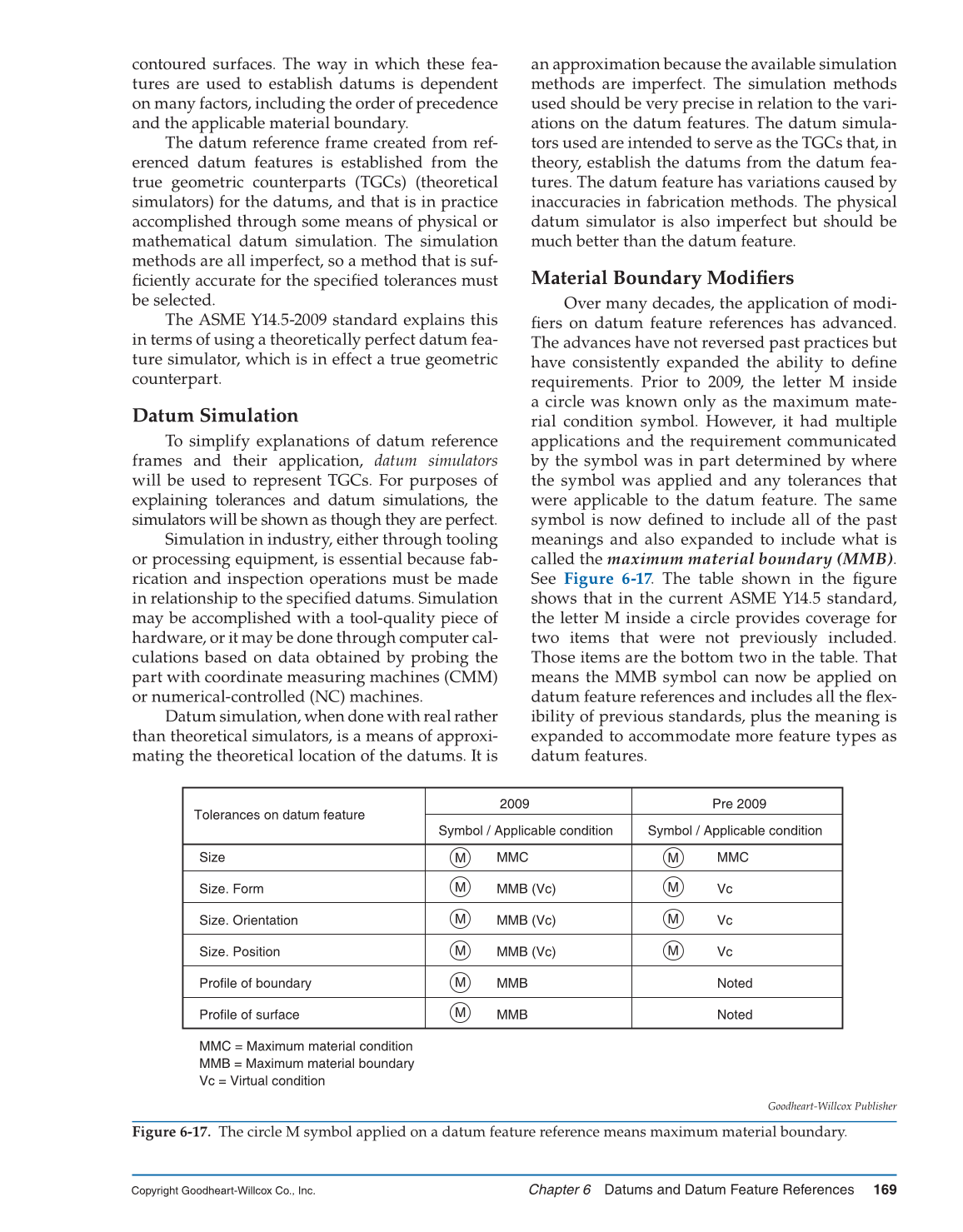Chapter 6 Datums and Datum Feature References 169
Copyright Goodheart-Willcox Co., Inc.
contoured surfaces. The way in which these fea-
tures are used to establish datums is dependent
on many factors, including the order of precedence
and the applicable material boundary.
The datum reference frame created from ref-
erenced datum features is established from the
true geometric counterparts (TGCs) (theoretical
simulators) for the datums, and that is in practice
accomplished through some means of physical or
mathematical datum simulation. The simulation
methods are all imperfect, so a method that is suf-
fi ciently accurate for the specifi ed tolerances must
be selected.
The ASME Y14.5-2009 standard explains this
in terms of using a theoretically perfect datum fea-
ture simulator, which is in effect a true geometric
counterpart.
Datum Simulation
To simplify explanations of datum reference
frames and their application, datum simulators
will be used to represent TGCs. For purposes of
explaining tolerances and datum simulations, the
simulators will be shown as though they are perfect.
Simulation in industry, either through tooling
or processing equipment, is essential because fab-
rication and inspection operations must be made
in relationship to the specifi ed datums. Simulation
may be accomplished with a tool-quality piece of
hardware, or it may be done through computer cal-
culations based on data obtained by probing the
part with coordinate measuring machines (CMM)
or numerical-controlled (NC) machines.
Datum simulation, when done with real rather
than theoretical simulators, is a means of approxi-
mating the theoretical location of the datums. It is
an approximation because the available simulation
methods are imperfect. The simulation methods
used should be very precise in relation to the vari-
ations on the datum features. The datum simula-
tors used are intended to serve as the TGCs that, in
theory, establish the datums from the datum fea-
tures. The datum feature has variations caused by
inaccuracies in fabrication methods. The physical
datum simulator is also imperfect but should be
much better than the datum feature.
Material Boundary Modifi ers
Over many decades, the application of modi-
fi ers on datum feature references has advanced.
The advances have not reversed past practices but
have consistently expanded the ability to defi ne
requirements. Prior to 2009, the letter M inside
a circle was known only as the maximum mate-
rial condition symbol. However, it had multiple
applications and the requirement communicated
by the symbol was in part determined by where
the symbol was applied and any tolerances that
were applicable to the datum feature. The same
symbol is now defi ned to include all of the past
meanings and also expanded to include what is
called the maximum material boundary (MMB).
See Figure 6-17. The table shown in the fi gure
shows that in the current ASME Y14.5 standard,
the letter M inside a circle provides coverage for
two items that were not previously included.
Those items are the bottom two in the table. That
means the MMB symbol can now be applied on
datum feature references and includes all the fl ex-
ibility of previous standards, plus the meaning is
expanded to accommodate more feature types as
datum features.
Tolerances on datum feature
2009 Pre 2009
Symbol / Applicable condition Symbol / Applicable condition
Size MMC MMC
Size. Form MMB (Vc) Vc
Size. Orientation MMB (Vc) Vc
Size. Position MMB (Vc) Vc
Profile of boundary MMB Noted
Profile of surface MMB Noted
MMC = Maximum material condition
MMB = Maximum material boundary
Vc = Virtual condition
M
M
M
M
M
M
M
M
M
M
Goodheart-Willcox Publisher
Figure 6-17. The circle M symbol applied on a datum feature reference means maximum material boundary.
